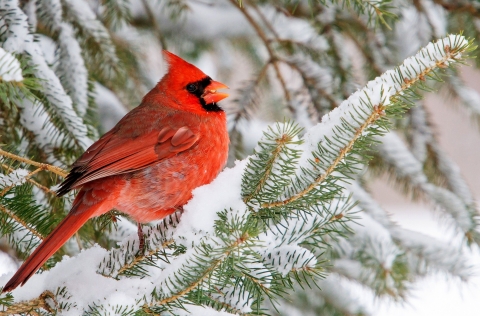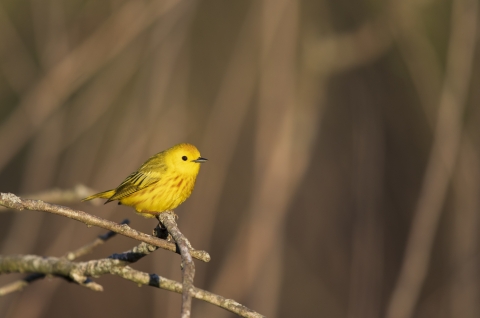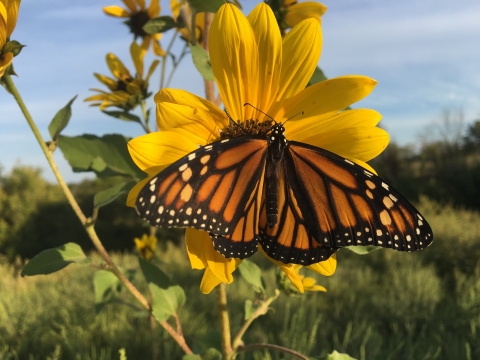Seasons of Wildlife
Minnesota Valley National Wildlife Refuge provides beautiful, protected habitats that are home to numerous species of unique and charismatic plants and animals. Refuge lands are managed in part for migrating waterfowl, and the wetlands and floodplain forests found throughout the refuge are important nesting and feeding areas for ducks, geese and swans. Wood ducks peek from their nests in tree cavities, geese and swans emerge from the wetland grasses with their young and many other waterfowl species stopping to feed on their long migratory journeys find habitats protected from development.
Winter
White-tailed deer, turkeys, squirrels, rabbits, mink, occasional river otters, songbirds such as northern cardinals, dark-eyed juncos, downy, hairy, red-bellied and pileated woodpeckers, black-capped chickadees, white-breasted nuthatches and blue jays can be seen in the oak savanna and other forested habitats. Wetlands are home to trumpeter swans, Canada geese, common and hooded mergansers and mallard ducks. In the snow you may see a wing print of great horned or barred owls, or a red-tailed hawk. Look closely in the snow and leafy debris for trails of mice and voles. Lift your eyes to the tops of tall cottonwoods to look for bald eagles returning to their roost sites and adding branches to the nests.
Spring and Fall
The refuge is an important stopover for migratory birds including warblers and other songbirds. Several species of waterfowl and waterbirds can be seen including wood ducks, mallards, northern pintails, northern shovelers, blue-winged teal, tundra swans and American white pelicans. Other wildlife observations may include beavers, muskrats, river otters and sandhill cranes. In the morning, the refuge awakens with the sounds of chorus, green and leopard frogs.
Look in spring for ephemerals in woods or stream banks such as bloodroot, Dutchman’s breeches, jack-in-the pulpit, nodding trillium and others. Look for the rare, state-threatened kittentails in the oak savanna habitats.
Summer
Snapping and painted turtles can be seen in wetland areas laying eggs. Garter and bull snakes might be seen sunning on trail edges and sun-warmed rocks. Great egrets, great blue herons and nesting waterfowl such as mallards, hooded mergansers, wood ducks and Canada geese are rearing their young in and around wetlands and the Minnesota River. Be aware of biting insects like mosquitoes, black flies and ticks, but also look for butterflies such as monarchs, painted ladies, red admirals and tiger swallowtails. Summer brings several species of native prairie plants in grasslands such as whorled, green, common and butterfly milkweed, prairie smoke and seas of native grasses blowing in the wind.
Featured Species
Many species that are considered threatened or endangered have been found within the refuge as well. Northern long-eared bats, rusty-patched bumblebees and rare freshwater mussel species all enjoy the benefits of protected habitats throughout the refuge. Tallgrass prairie habitats are protected and restored at the refuge and provide excellent native plant areas for numerous species of butterflies, including the iconic monarch butterfly.
Bald Eagle
Through protections under the Bald and Golden Eagle Protection Act, numerous bald eagles nest and rear their young atop massive cottonwood trees found in the Minnesota River Valley. Visitors can observe bald eagles from a safe distance in many areas of the refuge, often only moments from the busy Twin Cities metro area.






